With a phototransistor optocoupler, the output current is roughly proportional to the input current, and during the zero crossings of the AC input, the output is off.
As shown in application note AN-3007, the MID400 has much higher amplification (resulting in an essentially digital output), and is slower:

The Photodiode, D3, is coupled into a high gain 3 stage emitter follower current amplifier (Q1Q3Q5) driving into an output transistor Q8. The emitter follower loads are comprised of constant current circuits formed by Q2, R2, Q4, R3, Q6, and R4. Constant current level in these devices is established by the constant voltage source formed by the base emitter voltage of Q7 and R5.
[…]
Switching time of the amplifier is intentionally designed to be slow, so that the MID400 only responds to an absence of input signal over a few milliseconds, and not during the short zero-crossing period of the AC input voltage waveform.
So you would use the MID400 if you needed more output current without loading the AC input too much, or if you did not want to smooth the output signal in your own circuit or in software.
